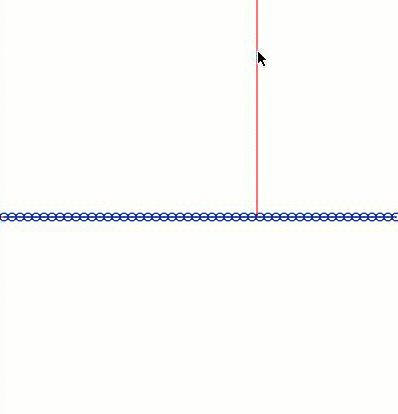Я попробовал это.
Брызги (пружины)
Как упоминается в этом уроке , поверхность воды похожа на проволоку: если вы потянете за какую-то точку проволоки, точки рядом с этой точкой также будут смещены вниз. Все точки также возвращаются к базовой линии.
Это в основном много вертикальных пружин рядом друг с другом, которые также тянут друг друга.
Я набросал это в Lua, используя LÖVE, и получил это:

Выглядит правдоподобно О, Хук , ты красивый гений.
Если вы хотите поиграть с ним, вот вам JavaScript от Фила ! Мой код находится в конце этого ответа.
Фоновые волны (сложенные синусы)
Естественные фоновые волны выглядят для меня как синусоидальные волны (с разными амплитудами, фазами и длинами волн), которые суммируются вместе. Вот как это выглядело, когда я писал это:

Интерференционные картины выглядят довольно правдоподобно.
Теперь все вместе
Итак, довольно просто суммировать всплески и фоновые волны:

Когда происходят всплески, вы можете видеть маленькие серые круги, показывающие, где будет исходная фоновая волна.
Это похоже на то видео, которое вы связали , поэтому я считаю это успешным экспериментом.
Вот мой main.lua(единственный файл). Я думаю, что это вполне читабельно.
-- Resolution of simulation
NUM_POINTS = 50
-- Width of simulation
WIDTH = 400
-- Spring constant for forces applied by adjacent points
SPRING_CONSTANT = 0.005
-- Sprint constant for force applied to baseline
SPRING_CONSTANT_BASELINE = 0.005
-- Vertical draw offset of simulation
Y_OFFSET = 300
-- Damping to apply to speed changes
DAMPING = 0.98
-- Number of iterations of point-influences-point to do on wave per step
-- (this makes the waves animate faster)
ITERATIONS = 5
-- Make points to go on the wave
function makeWavePoints(numPoints)
local t = {}
for n = 1,numPoints do
-- This represents a point on the wave
local newPoint = {
x = n / numPoints * WIDTH,
y = Y_OFFSET,
spd = {y=0}, -- speed with vertical component zero
mass = 1
}
t[n] = newPoint
end
return t
end
-- A phase difference to apply to each sine
offset = 0
NUM_BACKGROUND_WAVES = 7
BACKGROUND_WAVE_MAX_HEIGHT = 5
BACKGROUND_WAVE_COMPRESSION = 1/5
-- Amounts by which a particular sine is offset
sineOffsets = {}
-- Amounts by which a particular sine is amplified
sineAmplitudes = {}
-- Amounts by which a particular sine is stretched
sineStretches = {}
-- Amounts by which a particular sine's offset is multiplied
offsetStretches = {}
-- Set each sine's values to a reasonable random value
for i=1,NUM_BACKGROUND_WAVES do
table.insert(sineOffsets, -1 + 2*math.random())
table.insert(sineAmplitudes, math.random()*BACKGROUND_WAVE_MAX_HEIGHT)
table.insert(sineStretches, math.random()*BACKGROUND_WAVE_COMPRESSION)
table.insert(offsetStretches, math.random()*BACKGROUND_WAVE_COMPRESSION)
end
-- This function sums together the sines generated above,
-- given an input value x
function overlapSines(x)
local result = 0
for i=1,NUM_BACKGROUND_WAVES do
result = result
+ sineOffsets[i]
+ sineAmplitudes[i] * math.sin(
x * sineStretches[i] + offset * offsetStretches[i])
end
return result
end
wavePoints = makeWavePoints(NUM_POINTS)
-- Update the positions of each wave point
function updateWavePoints(points, dt)
for i=1,ITERATIONS do
for n,p in ipairs(points) do
-- force to apply to this point
local force = 0
-- forces caused by the point immediately to the left or the right
local forceFromLeft, forceFromRight
if n == 1 then -- wrap to left-to-right
local dy = points[# points].y - p.y
forceFromLeft = SPRING_CONSTANT * dy
else -- normally
local dy = points[n-1].y - p.y
forceFromLeft = SPRING_CONSTANT * dy
end
if n == # points then -- wrap to right-to-left
local dy = points[1].y - p.y
forceFromRight = SPRING_CONSTANT * dy
else -- normally
local dy = points[n+1].y - p.y
forceFromRight = SPRING_CONSTANT * dy
end
-- Also apply force toward the baseline
local dy = Y_OFFSET - p.y
forceToBaseline = SPRING_CONSTANT_BASELINE * dy
-- Sum up forces
force = force + forceFromLeft
force = force + forceFromRight
force = force + forceToBaseline
-- Calculate acceleration
local acceleration = force / p.mass
-- Apply acceleration (with damping)
p.spd.y = DAMPING * p.spd.y + acceleration
-- Apply speed
p.y = p.y + p.spd.y
end
end
end
-- Callback when updating
function love.update(dt)
if love.keyboard.isDown"k" then
offset = offset + 1
end
-- On click: Pick nearest point to mouse position
if love.mouse.isDown("l") then
local mouseX, mouseY = love.mouse.getPosition()
local closestPoint = nil
local closestDistance = nil
for _,p in ipairs(wavePoints) do
local distance = math.abs(mouseX-p.x)
if closestDistance == nil then
closestPoint = p
closestDistance = distance
else
if distance <= closestDistance then
closestPoint = p
closestDistance = distance
end
end
end
closestPoint.y = love.mouse.getY()
end
-- Update positions of points
updateWavePoints(wavePoints, dt)
end
local circle = love.graphics.circle
local line = love.graphics.line
local color = love.graphics.setColor
love.graphics.setBackgroundColor(0xff,0xff,0xff)
-- Callback for drawing
function love.draw(dt)
-- Draw baseline
color(0xff,0x33,0x33)
line(0, Y_OFFSET, WIDTH, Y_OFFSET)
-- Draw "drop line" from cursor
local mouseX, mouseY = love.mouse.getPosition()
line(mouseX, 0, mouseX, Y_OFFSET)
-- Draw click indicator
if love.mouse.isDown"l" then
love.graphics.circle("line", mouseX, mouseY, 20)
end
-- Draw overlap wave animation indicator
if love.keyboard.isDown "k" then
love.graphics.print("Overlap waves PLAY", 10, Y_OFFSET+50)
else
love.graphics.print("Overlap waves PAUSED", 10, Y_OFFSET+50)
end
-- Draw points and line
for n,p in ipairs(wavePoints) do
-- Draw little grey circles for overlap waves
color(0xaa,0xaa,0xbb)
circle("line", p.x, Y_OFFSET + overlapSines(p.x), 2)
-- Draw blue circles for final wave
color(0x00,0x33,0xbb)
circle("line", p.x, p.y + overlapSines(p.x), 4)
-- Draw lines between circles
if n == 1 then
else
local leftPoint = wavePoints[n-1]
line(leftPoint.x, leftPoint.y + overlapSines(leftPoint.x), p.x, p.y + overlapSines(p.x))
end
end
end



